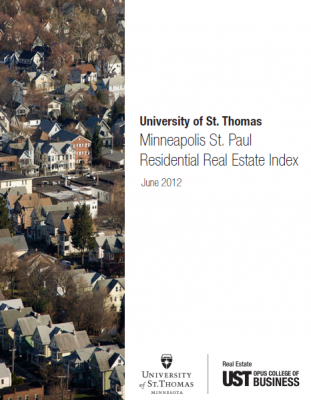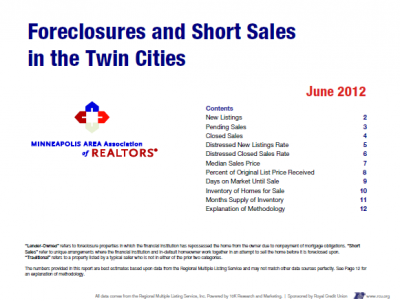 In 2011, The University of St. Thomas Opus College of Business started producing a report called the “Minneapolis St. Paul Residential Real Estate Index.” I had heard about it at some point last year but didn’t pay much attention.
In 2011, The University of St. Thomas Opus College of Business started producing a report called the “Minneapolis St. Paul Residential Real Estate Index.” I had heard about it at some point last year but didn’t pay much attention.
Then this year when I saw the report’s authors being quoted in the local news media and the numbers they were reciting, a strange feeling hit me. I had seen these numbers before. I then did some research and looked over the entire contents of several months of their reports and my suspicions were confirmed.
The University of St Thomas Residential Real Estate Index has been developed by the Shenehon Center for Real Estate at the University of St. Thomas Opus College of Business to correct the overstatement of housing price decline reported by the S&P Case-Shiller Price Index for the Minneapolis–St. Paul metropolitan area. Rather than a single index or price representative of all homes, the UST Residential Real Estate Index includes the price of homes in three sub-markets: traditional sales, short sales and foreclosure sales as well as a nine variable composite index for measuring market health for each category based on a three-month moving average.
-”About the Index” from their report
Almost all of the data they use in their report were numbers taken from a report that my local association, the Minneapolis Area Association of REALTORS, produces monthly from data derived from our local MLS, NorthstarMLS. This data could not be derived from any public data source, plain and simple.
MAAR has a long track record of encouraging its members and the public to utilize their reports to remain informed. I too share that ideal. The problem is that the St. Thomas report does not once reference MAAR, NorthstarMLS, REALTOR, MLS or Minneapolis Area Association of REALTORS anywhere in their reports. This is astonishing to me as I am certain they would punish any student who would submit a report so reliant on others’ data without attribution for a class project.
They present several pages of explanation of the market trends and their perspective and opinions of the same but the only data in their report that is their own are the Index values they display on page 3. Even those values are based off the numbers from MAAR’s research and reports and would not be able to be created without the underlying data.
The St. Thomas report breaks the housing market data up into three sub markets: Foreclosures, Short Sales and Traditional Sellers. What they don’t explain in their paper is exactly how those homes are classified into each category. For the methodology that MAAR uses, see the last page of MAAR’s Foreclosure and Short Sales in the Twin Cities report.
Due to the nature of the MLS’s data fields, seller privacy concerns and REALTOR customs, some of the reporting is derived from subjective MLS remarks fields which does add some potential for inaccuracy, but in a sample hand count I did of 300 (10%) of the sales in December 2011, the report’s margin of error was only about 3%.
While you are looking at the methodology, you may see my name at the very bottom- I was the co-creator of the methodology and the original report in 2008 that first started to analyze the distressed sale MLS data in our market… and I believe it was a first for any market. I have also been heavily involved in the methodology revisions and the report’s evolution over the last four years. All told, I would estimate I’ve invested approximately 100 hours into the project since I first looked into the phenomena in 2007 and MAAR now uses the data from this report in some of its other reports as well. I am not looking for personal credit on this, just credit to RMLS for the raw data and to MAAR for their report.
MAAR has been using the term “Traditional Sellers” to describe non-distressed sales longer than almost anyone else I could find. As I have shown, they have been reporting data for foreclosures, short sales and traditional sellers since 2008. Much of St. Thomas’s report focuses around the concept that foreclosures and short sales do not accurately depict our housing market’s value and I agree (1,2).
Most REALTORS are united in the philosophy that presenting the most transparent and accurate market statistics leads to benefits for all of us. Partnerships with others outside the real estate industry have the potential to unlock an even greater understanding of the housing market and its influence. We have a lot to learn about the last decade of real estate so that we can better understand, forecast and guide into the future. Let’s work this problem together, but please give credit where credit is due.
Full disclosure: I am a REALTOR-member of MAAR and have volunteered in numerous capacities for MAAR over my career. I am not and have never been an employee of MAAR. The views and opinions expressed in this article are my own and not necessarily those of MAAR, NorthstarMLS, or its members.
7/25/12 update: Herb Tousley from St. Thomas contacted me and said that future editions of the report will reference MAAR and NorthstarMLS as the source of the data.




